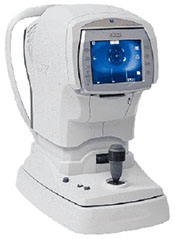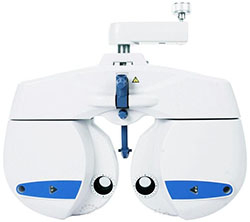At Prism Eye Care Inc., we use state-of-the-art equipment to properly examine your eyes, ensuring your prescription is accurate and your eyes free of disease. As members of the American Optometric Association, we stay up on changes in medicine and advances in technology, mastering innovative techniques and methods in order to give you the best possible eye care.
 Autorefractor
Autorefractor
An autorefractor is a computer-controlled machine used during an eye exam to help determine visual acuity. It provides an objective measurement of a person's refractive error and prescription for glasses or contact lenses. This is achieved by measuring how light is changed as it enters a person's eye. The autorefractor has been in use since the 1970’s because of its’ ease of use and accuracy.
Daytona Retinal Imaging Device - Optos
 Retinal imaging allows optometrists to see signs of eye diseases that they couldn’t see before. The test itself is painless and the results are easy for optometrists to interpret.
Retinal imaging allows optometrists to see signs of eye diseases that they couldn’t see before. The test itself is painless and the results are easy for optometrists to interpret.
In addition to helping detect diseases early, retinal images provide a permanent and historical record of changes in your eye. Through retinal imaging technology, Prism Eye Care Optometrists can diagnose: Macular degeneration and Ocular cancers.
Digital retinal imaging uses high-resolution imaging systems to take pictures of the inside of your eye. This helps our optometrists assess the overall health of your retina and helps them to detect and manage such eye and health conditions as diabetes, glaucoma, and existing macular degeneration.
Retinal imaging plays a critical role in the diagnosis and on-going management of diabetic retinopathy.
 Humphrey Zeiss The Frequency Doubling Technology (FDT) Visual Field Machine
Humphrey Zeiss The Frequency Doubling Technology (FDT) Visual Field Machine
A visual field test is an eye examination that can detect dysfunction in central and peripheral vision which may be caused by various medical conditions such as glaucoma, stroke, pituitary disease, brain tumors or other neurological deficits.
Visual field testing maps the visual fields of each eye individually and can detect blind spots (scotomas) as well as more subtle areas of dim vision. The visual field test is a subjective examination, so the patient must be able to understand the testing instructions, fully cooperate, and complete the entire visual test in order to provide beneficial information to the optometrist.
Auto Refractor Optical Phoropter
 A phoropter or refractor is an ophthalmic testing device that provides an objective reading prior to the subjective tests that follow on a phoropter. An auto refractor works by shining light into the eye and measuring how it bounces off the back of the eye.
A phoropter or refractor is an ophthalmic testing device that provides an objective reading prior to the subjective tests that follow on a phoropter. An auto refractor works by shining light into the eye and measuring how it bounces off the back of the eye.
It is commonly used by an optometrist during an eye examination, and contains different lenses used for refraction of the eye during sight testing, to measure an individual's refractive error and determine his or her eyeglass prescription.


 Autorefractor
Autorefractor Retinal imaging allows optometrists to see signs of eye diseases that they couldn’t see before. The test itself is painless and the results are easy for optometrists to interpret.
Retinal imaging allows optometrists to see signs of eye diseases that they couldn’t see before. The test itself is painless and the results are easy for optometrists to interpret. Humphrey Zeiss The Frequency Doubling Technology (FDT) Visual Field Machine
Humphrey Zeiss The Frequency Doubling Technology (FDT) Visual Field Machine A phoropter or refractor is an ophthalmic testing device that provides an objective reading prior to the subjective tests that follow on a phoropter. An auto refractor works by shining light into the eye and measuring how it bounces off the back of the eye.
A phoropter or refractor is an ophthalmic testing device that provides an objective reading prior to the subjective tests that follow on a phoropter. An auto refractor works by shining light into the eye and measuring how it bounces off the back of the eye.